So it’s been over a week since the Lightning Maroon’s first date. I left for MACNA XXII in Orlando Wednesday night (9-1), and returned on Sunday (9-5). Between then, my wife cared for the tanks for a day, and then my good friend Jay took over for Friday-Sunday.
So Jay told me that our little Lightning had been “sulking” and indeed, when I got home on Sunday, the coloration was darker and the fish was indeed sulking. It still ate well once food was introduced. Is the Lighting Maroon heartbroken? Not sure. Things looked OK, but I’m not one for taking chances, so a water change was performed. The tank housing the Lightning Maroon has developed a bit of a cyanobacteria (Red Slime Algae) problem since I had to swap out lights, and on Monday night, I gave the tank another 25% water change.
Still, the Lightning Maroon just doesn’t seem happy. It ate alright, but seemed to sulk in the back corner. The dorsal fin damage incurred from the “date” had fully healed. But tonight, I noticed, the right pectoral fin has a big chunk missing from the lower half. I am beyond stumped…I think I would have noticed damage like this after the “date”. No, I think this is something new. But what is it?
Of course, my heart races at the thought that this is some sort of fin rot. Without harassing the fish excessively however, it doesn’t really look like fin rot, no it kindof looks more like mechanical damage that is healing. It’s really hard to tell. Did one of the tankmates grab this fish through the egg crate and cause this damage? There is only one fish in the tank that could cause this – the Labrador Maroon. But still, it doesn’t look like that’s the case either. The damage has a wierd shape to it, as if the fin was nipped multiple times…perhaps by a Bristletail Filefish?
I’m stumped. I did my best to get some pictures. I just can’t get close enough to see what is really going on. I did a 25% water change earlier this evening, and again tonight, trying to remove as much of the cyanobacteria as possible. Out came the carbon and phosban. While Christine Williams is going to give me all sorts of grief over this, I dosed the tank tonight with Maracyn SW. I am comfortable with it as a prophalactic and I know it will knock back the cyano in the tank that has smothered a frag or two. I will be watching carefully tonight and will reassess in the morning. For now, the Lightning is still eating, which is always a good sign. I am hoping this is just mechanical damage and I’m overreacting.
Of course, if you owned the fish that got a standing ovation at the MACNA XXII banquet Saturday night during David Vosseler’s presentation on PNG SEASMART, you might be overreacting, or “extra cautious” too. OK, maybe not quite a standing ovation, but seriously, 1300 people applauding the Lightning Maroon? More on MACNA in a later post…this seemed more pressing of an update.
The net result is this – if this is mechanical damage, I think I have to allow the Lighting Maroon to become a female. I cannot risk this type of interaction occurring again. After all, this fish is in the most stable, well filtered aquarium I have, and it is in an egg-crate cage, and somehow it still winds up with half a pectoral fin missing? You’d be scratching your head too…
I shot 50 images and NONE show the damage on the pectoral fin with any amount of clarity. Will try again later. All around a frustrating day in the world of the Lighting Maroon!
- About The Lightning Project
- Inventory of F1 PNG Lightning and White Stripe Maroon Clownfish
- F1 PNG Lightning Maroon Clownfish, BZLM1
- F1 PNG Lightning Maroon Clownfish, BZLM2
- F1 PNG Lightning Maroon Clownfish, FW1
- F1 PNG Lightning Maroon Clownfish, LM10
- F1 PNG Lightning Maroon Clownfish, LM11
- F1 PNG Lightning Maroon Clownfish, LM12
- F1 PNG Lightning Maroon Clownfish, LM13
- F1 PNG Lightning Maroon Clownfish, LM14
- F1 PNG Lightning Maroon Clownfish, LM15
- F1 PNG Lightning Maroon Clownfish, LM16
- F1 PNG Lightning Maroon Clownfish, LM17
- F1 PNG Lightning Maroon Clownfish, LM18
- F1 PNG Lightning Maroon Clownfish, LM19
- F1 PNG Lightning Maroon Clownfish, LM20
- F1 PNG Lightning Maroon Clownfish, LM3
- F1 PNG Lightning Maroon Clownfish, LM4
- F1 PNG Lightning Maroon Clownfish, LM5
- F1 PNG Lightning Maroon Clownfish, LM6
- F1 PNG Lightning Maroon Clownfish, LM7
- F1 PNG Lightning Maroon Clownfish, LM8
- F1 PNG Lightning Maroon Clownfish, LM9
- F1 PNG Lightning Maroon Clownfish, MD1
- F1 PNG Lightning Maroon Clownfish, MWP3
- F1 PNG Lightning Maroon Clownfish, WS17
- F1 PNG Lightning Maroon, EC1
- F1 PNG Lightning Maroon, GL1
- F1 PNG White Stripe Maroon Clownfish, BZWS1
- F1 PNG White Stripe Maroon Clownfish, BZWS2
- F1 PNG White Stripe Maroon Clownfish, BZWS3
- F1 PNG White Stripe Maroon Clownfish, WS10
- F1 PNG White Stripe Maroon Clownfish, WS11
- F1 PNG White Stripe Maroon Clownfish, WS12
- F1 PNG White Stripe Maroon Clownfish, WS13
- F1 PNG White Stripe Maroon Clownfish, WS14
- F1 PNG White Stripe Maroon Clownfish, WS15
- F1 PNG White Stripe Maroon Clownfish, WS16
- F1 PNG White Stripe Maroon Clownfish, WS4
- F1 PNG White Stripe Maroon Clownfish, WS5
- F1 PNG White Stripe Maroon Clownfish, WS6
- F1 PNG White Stripe Maroon Clownfish, WS7
- F1 PNG White Stripe Maroon Clownfish, WS8
- F1 PNG White Stripe Maroon Clownfish, WS9
- F1 PNG White Stripe Maroon, EC2
- F1 PNG White Stripe Maroon, FW2
- F1 PNG White Stripe Maroon, GL2
- F1 PNG White Stripe Maroon, MD2
- Lightning Breeding Directive
- Lightning Maroon Clownfish Links
- Home
- About The Lightning Project
- Inventory of F1 PNG Lightning and White Stripe Maroon Clownfish
- F1 PNG Lightning Maroon Clownfish, BZLM1
- F1 PNG Lightning Maroon Clownfish, BZLM2
- F1 PNG Lightning Maroon Clownfish, FW1
- F1 PNG Lightning Maroon Clownfish, LM10
- F1 PNG Lightning Maroon Clownfish, LM11
- F1 PNG Lightning Maroon Clownfish, LM12
- F1 PNG Lightning Maroon Clownfish, LM13
- F1 PNG Lightning Maroon Clownfish, LM14
- F1 PNG Lightning Maroon Clownfish, LM15
- F1 PNG Lightning Maroon Clownfish, LM16
- F1 PNG Lightning Maroon Clownfish, LM17
- F1 PNG Lightning Maroon Clownfish, LM18
- F1 PNG Lightning Maroon Clownfish, LM19
- F1 PNG Lightning Maroon Clownfish, LM20
- F1 PNG Lightning Maroon Clownfish, LM3
- F1 PNG Lightning Maroon Clownfish, LM4
- F1 PNG Lightning Maroon Clownfish, LM5
- F1 PNG Lightning Maroon Clownfish, LM6
- F1 PNG Lightning Maroon Clownfish, LM7
- F1 PNG Lightning Maroon Clownfish, LM8
- F1 PNG Lightning Maroon Clownfish, LM9
- F1 PNG Lightning Maroon Clownfish, MD1
- F1 PNG Lightning Maroon Clownfish, MWP3
- F1 PNG Lightning Maroon Clownfish, WS17
- F1 PNG Lightning Maroon, EC1
- F1 PNG Lightning Maroon, GL1
- F1 PNG White Stripe Maroon Clownfish, BZWS1
- F1 PNG White Stripe Maroon Clownfish, BZWS2
- F1 PNG White Stripe Maroon Clownfish, BZWS3
- F1 PNG White Stripe Maroon Clownfish, WS10
- F1 PNG White Stripe Maroon Clownfish, WS11
- F1 PNG White Stripe Maroon Clownfish, WS12
- F1 PNG White Stripe Maroon Clownfish, WS13
- F1 PNG White Stripe Maroon Clownfish, WS14
- F1 PNG White Stripe Maroon Clownfish, WS15
- F1 PNG White Stripe Maroon Clownfish, WS16
- F1 PNG White Stripe Maroon Clownfish, WS4
- F1 PNG White Stripe Maroon Clownfish, WS5
- F1 PNG White Stripe Maroon Clownfish, WS6
- F1 PNG White Stripe Maroon Clownfish, WS7
- F1 PNG White Stripe Maroon Clownfish, WS8
- F1 PNG White Stripe Maroon Clownfish, WS9
- F1 PNG White Stripe Maroon, EC2
- F1 PNG White Stripe Maroon, FW2
- F1 PNG White Stripe Maroon, GL2
- F1 PNG White Stripe Maroon, MD2
- Lightning Breeding Directive
- Lightning Maroon Clownfish Links
I’ve been thinking, planning, and waiting, and for no reason whatsoever, tonight was the night. Time to allow the Lightning Maroon out of the jail cell for some exercise in the yard. Perhaps also time for a no-barriers meet-and-greet with the Labrador Maroon (a White Stripe variant of Premnas biaculeatus from unknown origins).
I could write about it, but why when I shot the whole thing on video?
So I realized I was wearing a white shirt, and with the metal halide pendent lighting I was totally getting in the way of the shot. After watching for a bit, I ran upstairs, changed into black, which is marginally better.
My initial take is that the Lightning Maroon MUST be male. This is the second time it has been introduced to a much larger Maroon and has not been mauled immediately. No, in fact, I am more worried about the male Centropyge argi (Caribbean Pygmy Angelfish) who is in this tank, and immediately wanted to show the Lightning Maroon who was boss (until the Labrador Maroon came to the rescue).
There are still people who will doubt that this video is actual “evidence” that the Lightning Maroon is in fact a male. So, I thought I’d do a bit of a demonstration. You may recall weeks ago I posted a note about one of the juvenile PNG Maroons jumping out of a breeder basket and getting attacked. Well, why not reintroduce this small male to the other fish in the tank. Once again, I don’t think I need to write anything, the video shows it pretty darn clearly. This is what happens when two Maroons of the same sex are introduced to each other.
And yes, as soon as I stopped the video I put down the camera and separated the two fish. The rest of this evening has been me sitting, anxiously, watching and observing, stepping away, coming back again, and wondering what’s next. The Maroons seem to be having a very good first date so far…
I personally believe the most telling observalble clue to the Lightning Maroon’s acceptance (and thus likely sex) is how the Labrador Maroon reacts to any other fish that enters this area. Totally different than the reactions to the Lightning Maroon’s presence. Seriously – check out the very tail end of this next video and watch how the Labrador Maroon reacts to the Dwarf Angelfish being in the “general area”.
So, I’ve kept the lights on late while I try to figure out my next moves. When I started this project, I pretty much planned on returning the Lightning Maroon back to “jail” for now, probably to live there at least until next week. But honestly, I figured if I was FORCED to remove the Lighting Maroon from the main tank, it’d be very easy…I figured the Labrador would be chasing it and keeping it OUT of the rockwork. Of course, the Lightning Maroon instead appears well accepted by the Labrador, and is hiding in the absolute least accessible area in the tank. Do I dismantle just to retrieve the fish?
There are two concerns. My first concern is that this initial pairing may be going well, but we all know stories of Maroon Clownfish females “turning” on their males. Would that happen here? Hard to say, but do I want to risk it? Honestly, right now is not really a good time to risk it as I won’t be in the ideal position to monitor things as often as I would want. My other concern is that the Centropyge argi male will beat the crap out of the Lightning Maroon. I’ve watched this huge pygmy angelfish (it’s the largest C. argi I’ve ever seen, longer than my thumb) go after a smaller Fire Clown (Amphiprion ephippium) who accidentally got out into the tank multiple times. Ultimately the Fire Clown did not recover. Do I want to risk the Lightning Maroon? Hard to say. It does seem that the Centropyge argi keep the Labrador Maroon preoccupied, which means that the Labrador is actually protecting the Lightning Maroon from them, but ALSO that they are keeping the Labrador Maroon distracted from turning aggressive towards the Lightning Maroon.
As you can see, it’s a really tough call. Another week or two and I’ll be in a much better position to monitor things. Of course, seeing these interactions further bolsters my insistence on obtaining a wild female Maroon Clownfish from PNG. That is truly the proper mate for the Lightning Maroon, and for now, while I lack the hard evidence I want (fertilized eggs), I do feel this video makes a strong case for not giving up on finding a suitable female from PNG. Either that, or I have to undergo a potentially arduous task of “creating” a PNG female out of the 4 juveniles I have on hand. That could take years! However, in the meantime, the Labrador Maroon seems to be doing the job I asked of it – keep the Lightning Maroon a male, and if you don’t mind, maybe start spawning so we can get some of those Lighting genetics preserved.
In the end, I pulled the tank apart and returned the Lighting Maroon to the safe-haven. I noticed that the Lightning Maroon had three splits in the rear portion of his dorsal fin as I captured it and put it back in jail. Was this from the Labrador Maroon? Or was it the fish I suspect more…the male Centropyge argi? I won’t know, but I do know that I think the next free-interactions between the Labrador Maroon and the Lighting Maroon may occur in slightly different circumstances.
For now, the lights are out. The tank is slightly rearranged. The Lightning Maroon is once again in a protective cage. It is back in the hands of the Labrador Maroon – please please please decide to spawn on the back wall of the tank so the Lightning Maroon can fertilize from relative safety!!!
Just some friendly advice. While doing a water change on the Lightning Maroon’s tank on Thursday, I noticed the flow from the Nanocube’s return pump seemed a little “slow”. I figured something was clogged up in the pump so I pulled it out to clean it.
Turns out, the impeller shaft must have become structurally weak, maybe cracked a bit, and become exposed to the saltwater. It had begun to rust, and in fact, had rusted straight through on its lower end. How the pump was even still running was a mystery to me. When smelling it, well, let me say that it SMELLED like metal. Strongly.
Of course, this was the original Italian Pump that the cubes came with…not like replacement parts are easily accessible here in northern Minnesota. The fact that it was probably around midnight didn’t help either, given that other than the local Petco, my local fish shops close at 6 or 6:30 PM (I’m still baffled by that…used to Chicago where everything was open until 8 or 9 PM).
Thankfully, I’ve taken my own advise for years now and I always keep a spare pump (a Maxijet) and a spare heater (a Stealth) on hand for these tanks. It only took a minute to replace the old Italian Pump with a brand new MaxiJet. A big bag of carbon went into just to help hopefully pull out some of the “metals” if there was any contamination in the water, but I’m thinking I may have really “broken things” when I took it out for cleaning. Still, I’ll be doing more water changes and frequent carbon changes to ensure that things are OK for the Lightning Maroon.
The $25 investment I made to have a brand new piece of equipment just lying around was obviously well worth it. Now I just need to go get a replacement as I’m once again, without a backup! The nice part is that since I have 3 of these Nanocubes on hand, I only need to have one replacement pump on hand to cover me for 3 tanks…the odds of 2 going out at the same time are unlikely. The $50 it cost me initially for some “piece of mind” on the heater and water pump backups prevented me from having to post a very different “status update” on this project.
Nothing else to report right now…all Maroons in the house are healthy and doing well, but none are breeding. I’m continuing to “pump” the big Labrador Maroon full of food to hopefully encourage a spawn. We are still very much in the “waiting game” aspects of this project.
Yes, the Lighting Maroon is currently still a Jailbird, and all of today’s mugshots were taken behind bars!
There is little to report at this time. All the Maroons in the house are happy and healthy. All the new PNG Juvies are going through QT still. The Labrador Maroon continues to renovate the tank outside of the Lightning Maroon’s new home (jail). I have not seen any breeding behavior on the part of the Labrador Maroon. I still do not have a good feeling about how these two fish would interact if I introduced them outright, although I’m getting ever more tempted and still believing that indeed, the Lighthing Maroon is still a male. I say this, because in observing the small PNG Male with the larger GSM female, the Lightning Maroon shared the same behaviors when it was paired with the original large PNG Female. No proof that it’s male, but definitely suggestive.
For now, enjoy a pictorial spread of the Lightning Maroon behind bars. And yes, he really does stare out the front at you like that!
There is simply nothing “new” to report. This is how clownfish breeding can go sometimes…you wait, and wait, and wait, and wait. At the request of Anderson, I needed to take some pictures today. A couple pictures of a large Maroon Clownfish with dark barring had surfaced on the internet, and he asked if I had seen them. Well, the “Labrador Maroon Clown” from Frank and Mary here in Duluth fits that description perfectly. I believe this darkening of the bars is one of the few possible changes that happens as Maroons reach uncommonly older ages (another common stripe change is the loss of the stripes).
Getting a good picture of the dark barred Maroon that is currently lurking outside the Lighting Maroon’s cage was beyond difficult, as the Labrador has been rearraning the tank for the past couple days and is refusing to come out and pose. So, two updates tonight. In this one, a photo spread of the Labrador Maroon, as best as I could get…
Just because the Morse Code Maroon failed to make it doesn’t mean that the Lighting Project is on hold. Far from it.
The Lightning Maroon is having problems….keeping anemones in the new cage! They keep LEAVING it, and the Lightning Clown has grown accustomed to having a BTA to frolic in. So I added some more tiles to the bottom of the cage, but still, the BTAs flee the scene! Not sure what I’m going to do here, if anything.
Remember my “jumpers”? Well, it turns out that the Sumatran Fire Clown was not jumping out of the breeder net, but escaping through a gaping hole that the Bristletail Filefish had gnawed in the netting. Yesterday, I found the Fire Clown in bad shape, pummeled by all three Centropyge argi and the big Labrador Maroon. I got it out, put it back in the net, and a couple hours later, found it again out of the net, beat up even more. It was then that I discovered the hole in the bottom of the net. The discovery came too late, and the Fire Clown was dead by morning. Now, this fish was never a risk to either Maroon Clown, as it was far smaller. I only share this story here to serve as a reminder of how vicious marine fish can be. I blame the Fire Clown however, for not learning the first and second time to stay IN THE NET where it was safe, and blame myself for not catching the hole sooner.
The Brooklynella on the remaining largest juvie PNG Maroon seems to have disappeared, and all 4 remaining juveniles are doing well. The one that jumped and got in a tiff with the other seems to be recovering quickly, and honestly may be my utlimate mate choice for the Lightning Maroon. But I have yet to really think all of that through now.
The big female Gold Stripe Maroon (GSMs are from Sumatra) from Jonica and Scott is settling in well and has taken a shine to her little PNG mate. There was never the slightest hint of aggression between these two fish. The female was shy, but a week on is starting to adjust to seeing me come at her from the side (Jonica can tell you that she lived in a big vat, the entire surface covered in Chaetomorpha, so the only way she saw humans for the past several months was from above). I had some new arrivals show up this week for another breeding project – Meiacanthus bundoon! They seemed like a great match for this mis-matched pair of Maroon Clowns. Sadly for Joncia’s GSM, her new “mate” is also up as a possible candidate as a mate to the Lightning Maroon…I like the color, and the fact that it has a broken tailbar to me says “increased chance of genetic predisposition to stripe variations”. I’ll close with some updated pictures of the GSM, her PNG Mate, and the new Bundoons!
A really quick post because there isn’t much to say. The Morse Code Maroon died this evening. Obviously I’m not surprised.
What has surprised me was some of the other fish. Yesterday was just a crazy day. First, I noticed that one of the small PNG Maroon juvies had jumped out of its breeder basket and was being mauled by the other. It’s only fin damage, but still..
Then, I noticed the same thing had happened with a spare Sumatran Fire Clown (A. ephippium) that lives in a breeder net in the same tank with the Lightning Maroon and the Labrador Maroon. Surprisingly, it was not only the Labrador Maroon, but also the 3 Centropyge argi in the tank, that were all pounding on this Fire Clown (and heck, Fire Clowns have their own reputation for viscous attitudes!) The Fire Clown was rescued as well and is recovering in his anemone. Hopefully he learned his lesson. So I’m left wondering what’s with all the jumpers! 2 fish in the same day?
The other surprise is thankfully more welcome – I had another first spawning on a species. Nothing terribly “fancy”, just a small, often overlooked damselfish. The specific species is still up for debate – I’m currently calling it Neopomacentrus cf. nemerus for the moment.
Off to feed Ethan. I’m technically late!
Short update, I got on the Morse Code Maroon this morning and swabbed the area with Hydrogen Peroxide. I am guessing this fish will likely be dead in the next 24 hours. Ordinarily, a fish in this condition would be euthanized. Warning, the picture is pretty darn graphic. The fish’s entire upper maxillary has been rotted through, leaving two pieces hanging. I would be truly amazed if this fish were able to turn around,, but without finding an antibiotic regiment that is affective, this fish is going to be another loss.
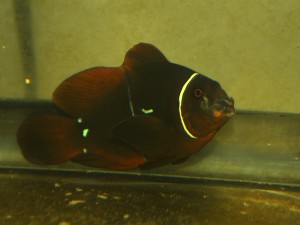
Sad to see this one going down this path, and really ticked that I found the problem early and addressed it early and it has still progressed unabated.
N0te – the yellow tint in the water is from the Maracyn / Maracyn Two.
Today was just a crazy day. A week in the making, I owe a bit of thanks to Jonica and her husband Scott (rest of her name withheld for privacy). They provided the impetus for a day long road trip from Duluth to the Twin Cities region to pick up another massive female Maroon Clownfish. This one happens to be a Gold Stripe Maroon (Sumatran form). She’s pretty darn big, although the “Labrador” female from Frank & Mary has at least another 2 inches on her! Thanks for this great donation to the cause. She’ll have a good home here!
As you may know, the *plan* for whatever big female I could find was to place her on the other side of the eggcrate with the “Morse Code” Maroon in the hopes of applying social pressure to test the sexuality of the Morse Code maroon, and hopefully keep it a male if it still could be a Male.
Let me say now that the Morse Code Maroon continues to decline despite being hit with both Maracyn and Maracyn Two in combination. So I’ve now thrown three antibiotics at this problem with no resolution. It’s a slow progressing infection, but frankly, I hate to see fish suffer for so long. Here’s where things looked tonight when I got home.
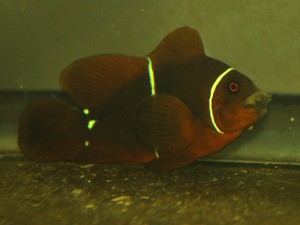
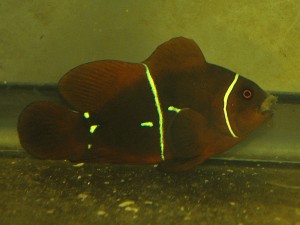
Now, I must say that I’m toying with swabbing that with Hydrogen Peroxide. At this point, what else can I really do?!
Meanwhile, there is no way, and arguably no point, to introduce the new female Gold Stripe Maroon on the other side of the divider. The Morse Code is lethargic to the point where social pressure isn’t going to do a darn thing for it. There’s no positive upside at the moment to risking the GSM, so instead, she was placed into one of the QT Tanks with one of the smallest 3 PNG Maroons. Submission was instantaneous on the part of the little Maroon, so it is safe to say that at minimum, this one small PNG Maroon will remain male until called upon for service!

IF by some crazy chance this pair happened to spawn, I may opt to rear the babies solely for practice, but all of them would be humanely euthanized. This may sound very cruel, but the reality is that such offspring are possible “hybrids” (there has been talk in the past that the Gold Stripe Maroon could be reclassified as a different species). Regardless, they would be a mixing of color variants / races, which for all intents and purposes is something fish breeders should strive to avoid. Afterall, I could hypothesize that the resultant offspring could turn out like either parent, or more likely a muddled version of a GSM. And the reality is they wouldn’t be discernible by the average hobbyist or even most breeders. In other words, there is NO upside to releasing such a fish into the hobby. So yes, they would be put down. But at least I would get some valuable experience rearing Premnas larvae. Long term though, this temporary pairing will be split up, and each fish ultimately placed with an appropriate mate.
Meanwhile, I finally found the time to do a bit of eggcrate and zip tie fabrication. The Lightning Maroon has been given a larger, more spacious home with a better view and the ability to better interact with the Labrador Maroon. If they couldn’t see each other before, now they can. The new eggcrate cage is pretty substantial. I’ve heard stories, I think one told to me by Carl Kmiec, of clownfish being able to fertilize a spawn even when separated by eggcrate, even several inches away. Could that happen in this situation? Who knows?!
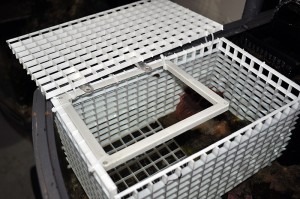
Hinged top opens to provide easy access. Used the frame from an old breeder net to provide easy hangers.
That’s going to be it for tonight! Catch you tomorrow!
So as it stands, the Morse Code Maroon Clown, the largest one that was shipped, got Maracyn SW last night after a 50% water change. That seems to have had no affect. So tonight, lacking guidance and having a bit of desperation based on the ever-declining health of this fish, I doubled down and added in Maracyn II SW. Mardel’s medications often suggest using combinations, but as it turns out, reading the details, there is never a discussion of using these two particular medications together. I’m running out of options on this fish, and it appears the fish is running out of time.
The second largest PNG Maroon shipped has shown signs of a mild Brooklynella infection. I hit the tank housing him with Formalin on Wed. night, and now again Friday night. The nice thing is that after the first treatment, his appetite returned.
The remaining 3, all the smallest, have shown no symptoms of disease. They all feed well and behave normally. The same goes for the smaller PNG Saddlebacks that I was also shipped this time around. I believe these observations lend further anecdotal evidence to the notion that if you’re going to buy wild caught clownfish, smaller, younger fish tend to suffer less in transit and prove more resilient. And frankly, wanting smaller clowns is probably a better way to go when talking about wild caught fish. Afterall, the juvenile clownfish harvested from the reef is not a large breeder, producing the future generations. So when it comes to sustainability, it makes sense to pursue juveniles for a myriad of reasons.
The Lightning Maroon, the star of our show, remains awesome as always.

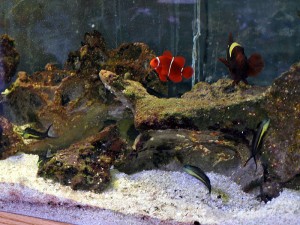
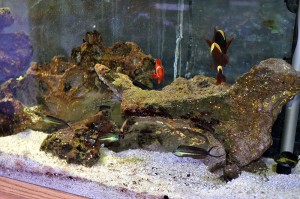
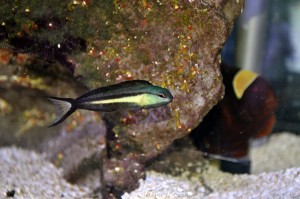
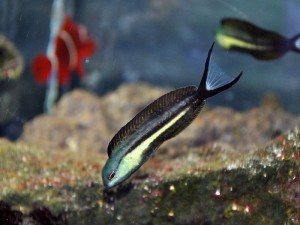
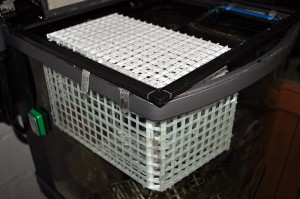
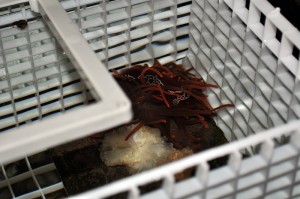
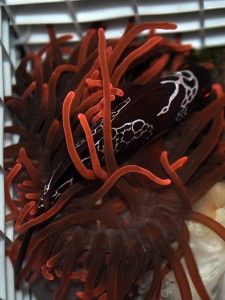
Recent Comments